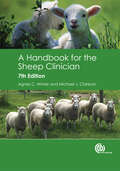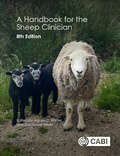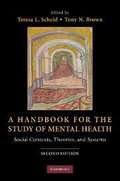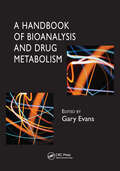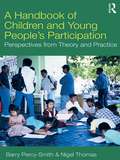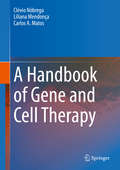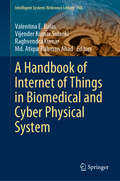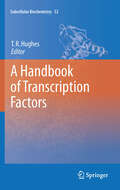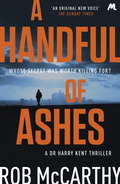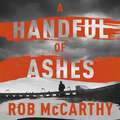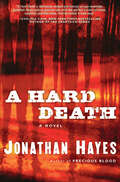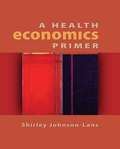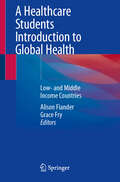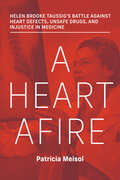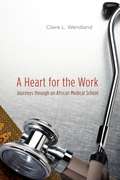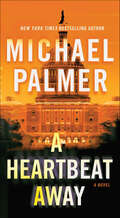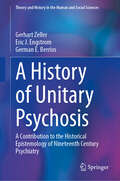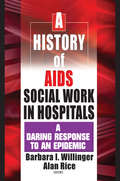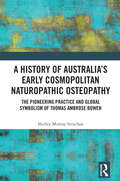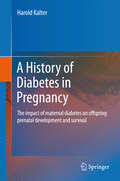- Table View
- List View
A Handbook for the Sheep Clinician
by Agnes Winter Michael ClarksonAn established favourite with veterinary and agricultural students and a valuable addition to the library of any veterinarian or sheep farmer, this handbook covers the basics of sheep medicine and production. Geared at being an on-farm reference, it concisely conveys all of the fundamental information for the treatment of sheep worldwide. In this fully updated and revised 7th edition, topics covered include reproduction, vaccination, pregnancy and newborns, lameness, parasites, diseases, neurology and health promotion. An emphasis on diagnosis and treatment combined with short, easily digestible chapters and step-by-step diagrams makes this book an essential practical guide to recognising, treating and preventing disease.
A Handbook for the Sheep Clinician
An established favourite with veterinary and agricultural students and a valuable addition to the library of any veterinarian or sheep farmer, this handbook covers the basics of sheep medicine and production. Geared at being an easily accessed reference, it clearly conveys fundamental information on the care and treatment of sheep worldwide. This fully updated and revised eighth edition: - continues to cover all important aspects of sheep production and health, including reproduction, vaccination, pregnancy and newborns, lameness, internal and external parasites and flock health promotion; - reviews general developments and advancements in sheep veterinary medicine, as well as disease prevalence by geographical spread and in relation to changing climate; - considers topics of increasing importance such as vaccine availability and drug resistance. An emphasis on diagnosis and treatment combined with short, easily-digestible chapters and step-by-step diagrams makes this book an essential practical guide to recognizing, treating and preventing disease.
A Handbook for the Study of Mental Health (2nd edition)
by Teresa L. Scheid Tony N. BrownThe 2nd edition of A Handbook for the Study of Mental Health: Contexts, Theories, and Systems provides a comprehensive review of the sociology of mental health, with chapters written by leading scholars and researchers. The volume presents an overview of historical, social, and institutional frameworks for understanding mental health and illness. Part I examines social factors that shape psychiatric diagnosis and the measurement of mental health and illness, the theories that explain the definition and treatment of mental disorders, and cultural variability in mental health. Part II investigates effects of social context on mental health and illness. Individual chapters consider the role of social statuses including class, gender, race, and age. Several chapters focus on the critical role played by stress, marriage, work, and social support, with a concluding chapter focusing on terrorism. Part III focuses on the organization, delivery, and evaluation of mental health services, including a discussion of the criminalization of mental illness, the mental health challenges posed by HIV, and the importance of stigma in meeting the mental health needs of individuals. A Handbook for the Study of Mental Health is a key research reference source that will be useful to both undergraduates and graduate students studying mental health and illness from any number of disciplines.
A Handbook for the Study of Mental Health: Social Contexts, Theories, and Systems
by Wright Scheid Teresa L. Eric R.With chapters written by leading scholars and researchers, the third edition of A Handbook for the Study of Mental Health provides an updated, comprehensive review of the sociology of mental health. The volume presents an overview of the historical, social, and institutional frameworks for understanding mental health and illness. Part I examines the social factors that shape psychiatric diagnosis and the measurement of mental health and illness, the theories that explain the definition and treatment of mental disorders, and cultural variability in mental health. The section addresses the DSM-5 and its potential influence on diagnosis and research on mental health outcomes. Part II investigates the effects of social context on mental health and illness. Part III focuses on the organization, delivery, and social context of mental health treatment. The chapters in Part III address the likely impact of the Affordable Care Act on mental health care. This volume is a key resource for students, researchers, advocates, and policymakers seeking to understand mental health and mental health delivery systems.
A Handbook of Bioanalysis and Drug Metabolism
by Gary EvansRecent years have seen a greater industrial emphasis in undergraduate and postgraduate courses in the pharmaceutical and chemical sciences. However, textbooks have been slow to adapt, leaving the field without a text/reference that is both instructional and practical in the industrial setting – until now. A Handbook of Bioanalysis and Drug Metabolismis a stimulating new text that examines the techniques, methodology, and theory of bioanalysis, pharmacokinetics, and metabolism from the perspective of scientists with extensive professional experience in drug discovery and development. These three areas of research help drug developers to optimize the active component within potential drugs thereby increasing their effectiveness, and to provide safety and efficacy information required by regulators when granting a drug license. Professionals with extensive experience in drug discovery and development as well as specialized knowledge of the individual topics contributed to each chapter to create a current and well-credentialed text. It covers topics such as high performance liquid chromatography, protein binding, pharmacokinetics and drug–drug interactions. The unique industrial perspective helps to reinforce theory and develop valuable analytical and interpreting skills. This text is an invaluable guide to students in courses such as pharmaceutical science, pharmacology, chemistry, physiology and toxicology, as well as professionals in the biotechnology industry.
A Handbook of Children and Young People's Participation: Perspectives from Theory and Practice
by Nigel Thomas Barry Percy-SmithA Handbook of Children and Young People's Participation brings together key thinkers and practitioners from diverse contexts across the globe to provide an authoritative overview of contemporary theory and practice around children’s participation. Promoting the participation of children and young people – in decision-making and policy development, and as active contributors to everyday family and community life – has become a central part of policy and programme initiatives in both majority and minority worlds. This book presents the most useful recent work in children’s participation as a resource for academics, students and practitioners in childhood studies, children’s rights and welfare, child and family social work, youth and community work, governance, aid and development programmes. The book introduces key concepts and debates, and presents a rich collection of accounts of the diverse ways in which children’s participation is understood and enacted around the world, interspersed with reflective commentaries from adults and young people. It concludes with a number of substantial theoretical contributions that aim to take forward our understanding of children’s participation. The emphasis throughout the text is on learning from the complexity of children’s participation in practice to improve our theoretical understanding, and on using those theoretical insights to challenge practice, with the aim of realising children’s rights and citizenship more fully.
A Handbook of Gene and Cell Therapy
by Clévio Nóbrega Liliana Mendonça Carlos A. MatosThis is a reference handbook for young researchers exploring gene and cell therapy. Gene therapy could be defined as a set of strategies modifying gene expression or correcting mutant/defective genes through the administration of DNA (or RNA) to cells, in order to treat disease. Important advances like the discovery of RNA interference, the completion of the Human Genome project or the development of induced pluripotent stem cells (iPSc) and the basics of gene therapy are covered. This is a great book for students, teachers, biomedical researchers delving into gene/cell therapy or researchers borrowing skills from this scientific field.
A Handbook of Internet of Things in Biomedical and Cyber Physical System (Intelligent Systems Reference Library #165)
by Raghvendra Kumar Valentina E. Balas Vijender Kumar Solanki Md. Atiqur Rahman AhadThis book presents a compilation of state-of-the-art work on biomedical and cyber-physical systems in connection with the Internet of Things, and successfully blends theory and practice. The book covers the studies belonging to Biomedical and Cyber-physical System, so it is a unique effort by the research experts, who are divulging in the domain deeply. The book is very easy for the audience, who are doing study in the Biomedical and Cyber-physical System; it helps to read some real-time scenarios from where the reader in general gets many sparking ideas to convert it into the research problems in their studies. This book is of use to solve down the problems of graduate, postgraduate, doctoral industry executives, who are involving in the cutting-edge work of Internet of Things with Biomedical or Cyber-physical System, with the help of real-time solutions, given in the formation of chapters by subject’s experts.The key uses of this book are in the area of Internet of Things in connection with Cyber-physical System as well as Biomedical domain.
A Handbook of Transcription Factors: Handbook Of Transcription Factors (Subcellular Biochemistry #52)
by Timothy R. HughesTranscription factors are the molecules that the cell uses to interpret the genome: they possess sequence-specific DNA-binding activity, and either directly or indirectly influence the transcription of genes. In aggregate, transcription factors control gene expression and genome organization, and play a pivotal role in many aspects of physiology and evolution. This book provides a reference for major aspects of transcription factor function, encompassing a general catalogue of known transcription factor classes, origins and evolution of specific transcription factor types, methods for studying transcription factor binding sites in vitro, in vivo, and in silico, and mechanisms of interaction with chromatin and RNA polymerase.
A Handful of Ashes: Dr Harry Kent Book 2 (Dr Harry Kent thrillers)
by Rob McCarthyCrime's most original series character returns in a gripping new case. Dr Harry Kent is on the edge...He works too hard, sleeps too little, hardly sees daylight. And then the Met police call him out to certify the suicide of a whistleblower from a world-renowned London children's hospital - a trainee children's surgeon who accused her boss of negligence. Except someone held Susan Bayliss down... The grieving parents of the children who died demand answers. The hospital is stonewalling. Everyone has secrets - it's up to Harry and DCI Frankie Noble to find out which were worth killing for. But Harry's taking this personally... and that means trouble's on its way.
A Handful of Ashes: Dr Harry Kent Book 2 (Dr Harry Kent thrillers)
by Rob McCarthyThe second thrilling book in the London-set Dr Harry Kent series, the perfect mix of detective novel and medical drama. Susan Bayliss became notorious when she blew the whistle on her boss, a heart surgeon at a renowned children's hospital. She accused him of negligence, operations were stopped and an inquiry launched. In the end she was the one suspended as a troublemaker. Now Dr Harry Kent, a medical examiner with the Met Police, has been called out to certify her suicide. But something about the scene is wrong. Someone held Susan down... The grieving parents of the children who died demand answers. The hospital is stonewalling. Everyone has secrets - it's up to Harry and DCI Frankie Noble to find out which were worth killing for.(P) 2017 Hodder & Stoughton
A Hard Death: A Novel (Edward Jenner Series #2)
by Jonathan HayesForensic pathologist Edward Jenner survived the horrific ordeal of the Inquisitor serial slayings in New York, but not the political fallout. With his state medical license suspended, he hopes to repair his shattered life while working as a medical examiner in Douglas County, Florida. But evil is not confined to big cities alone.Two corpses pulled from a sunken car—followed by the grisly discovery of four more bodies hanging in the Everglades—are evidence of an insidious rot infecting this quiet coastal resort community. Suddenly Jenner's investigation is turning up grim traces of a nightmarish conspiracy—and with no one to trust and nowhere to turn, his only hope of survival is to walk away . . . something Jenner could never do.
A Health Economics Primer
by Shirley Johnson-LansCovers the key areas of health care economics - the supply and demand for health care and health insurance, the impact of technological innovation, and the role of institutions and public policy. It aims to enable instructors to adapt the course, with suggestions for ways to use this text along with essential readings covering research debates.
A Healthcare Solution: A Patient-Centered, Resource Management Perspective (Resource Management)
by Mark A. Vonderembse David D. DobrzykowskiThe evidence is undeniable. By any measure, the US spends more on healthcare than any other country in the world, yet its health outcomes as measure by longevity are in the bottom half among developed countries, and its health-related quality of life has remained constant or declined since 1998. In addition to high costs and lower than expected outcomes, the healthcare delivery system is plagues by treatment delays as it can take weeks to see a specialist, and many people have limited or no access to care. Part of the challenge is that the healthcare delivery system is a large, complex, and sophisticated value creation chain. Successfully changing this highly interconnected system is difficult and time consuming because the underlying problems are hard to comprehend, the root causes are many, the solution is unclear, and the relationships among problems, causes, and solution are multifaceted. To address these issues, the book carefully explains the underlying problems, examines their root causes using information, data, and logic, and presents a comprehensive and integrated solution that addresses these causes. These three steps are the methodological backbone of this book. A solution depends on understanding and applying the principles of patient-centered care (PCC) and resource management. PCC puts patients, supported by their primary care physicians, back in the role as decision makers and depends on patients being responsible for their health including making good life-style choices. After all, the best way to reduce healthcare costs and increase quality of life is to improve our health and wellness and as a result need less care. In addition, health insurance must be rethought and redesigned so it is less likely to lead to overuse. For many people with health insurance, the out-of-pocket cost of healthcare are small, so healthcare decision making is often biased toward consumption. Effective resource management means that healthcare providers must do a better job of acquiring and using resources in order to provide care quickly, productively, and correctly. This means improving healthcare strategy and management, accelerating the use of information technology, making drug costs affordable and fair, reducing the incidence of malpractice, and rebuilding the provider network.In addition, implementation is difficult because there are many participants in the healthcare delivery value chain, such as physicians, nurses, and medical technicians, as well as many provider organizations, such as hospitals, clinics, physician offices, and labs. Further up the value chain there are pharmaceutical companies, equipment providers, and other suppliers. These participants have diverse and sometimes conflicting goals, but each must be willing to accept change and work in a coordinated manner to improve healthcare. To overcome these problems, strong national leadership is needed to get the attention and support from the people and organizations involved in healthcare and to make the comprehensive changes that will lower healthcare costs, improve healthcare quality, eliminate delays, increase access, and enhance patient satisfaction.
A Healthcare Students Introduction to Global Health: Low- and Middle Income Countries
by Alison Fiander Grace FryAimed at healthcare students: medical, nursing, and allied professionals, the textbook covers a broad range of topics in Global Health as investigated and summarized by Cardiff University medical students completing a short course in Global Health. Global Health is an increasingly important aspect of the undergraduate medical curriculum but is rarely formally taught at undergraduate level. It focuses upon health in Low- and Middle-Income Countries (LMIC). Chapters include: What is Global Health; changing demographics and disease burden; Humanitarian medicine, Aid; health in conflict; Sexual Reproductive Health; Gender Based Violence; child health; disability; cancer care; palliative care; infectious disease; neglected tropical disease; the climate crisis and sustainable healthcare, amongst others.
A Heart Afire: Helen Brooke Taussig's Battle Against Heart Defects, Unsafe Drugs, and Injustice in Medicine
by Patricia MeisolA deeply compelling biography of the pioneering children�s heart doctor Helen Taussig, who helped start heart surgery and became a global force against preventable suffering.
A Heart For The Work: Journeys Through An African Medical School
by Claire L. WendlandBurnout is common among doctors in the West, so one might assume that a medical career in Malawi, one of the poorest countries in the world, would place far greater strain on the idealism that drives many doctors. But, as A Heart for the Work makes clear, Malawian medical students learn to confront poverty creatively, experiencing fatigue and frustration but also joy and commitment on their way to becoming physicians. The first ethnography of medical training in the global South, Claire L. Wendland’s book is a moving and perceptive look at medicine in a world where the transnational movement of people and ideas creates both devastation and possibility. Wendland, a physician anthropologist, conducted extensive interviews and worked in wards, clinics, and operating theaters alongside the student doctors whose stories she relates. From the relative calm of Malawi’s College of Medicine to the turbulence of training at hospitals with gravely ill patients and dramatically inadequate supplies, staff, and technology, Wendland’s work reveals the way these young doctors engage the contradictions of their circumstances, shedding new light on debates about the effects of medical training, the impact of traditional healing, and the purposes of medicine.
A Heartbeat Away: A Novel
by Michael PalmerThe New York Times bestselling author and master of suspense delivers another novel at the crossroads of politics and medicine in this shocker of a thriller On the night of the State of the Union address, President James Allaire expects to give the speech of his career. But no one anticipates the terrifying turn of events that forces him to quarantine everyone in the Capitol building. A terrorist group calling itself "Genesis" has unleashed WRX3883, a deadly, highly contagious virus, into the building. No one fully knows the deadly effect of the germ except for the team responsible for its development—a team headed by Allaire, himself. The only one who might be able to help is virologist Griffin Rhodes, currently in solitary confinement in a maximum security federal prison for alleged terrorist acts, including the attempted theft of WRX3883 from the lab where he worked. Rhodes has no idea why he has been arrested, but when Allaire offers to free him in exchange for his help combating the virus, he reluctantly agrees to do what he can to support the government that has imprisoned him without apparent cause. Meanwhile, every single person in line for presidential succession is trapped inside the Capitol—every person except one: the Director of Homeland Security, who is safely at home in Minnesota, having been selected as the "Designated Survivor" for this event. With enemies both named and unnamed closing in, and the security of the nation at stake, Griff must unravel the mysteries of WRX3883 without violating his pledge as a scientist to use no animal testing in his experiments…and time is running out. Tense, thrilling, and entirely plausible, A Heartbeat Away will make you reflect, wonder, and be truly afraid.
A History of 'Unitary Psychosis': A Contribution to the Historical Epistemology of Nineteenth Century Psychiatry (Theory and History in the Human and Social Sciences)
by German E. Berrios Gerhart Zeller Eric J. EngstromGerhart Zeller&’s prize-winning 1961 study of the history of the concept of unitary psychosis has never before been published in German or English. To date, the manuscript remains by far the best historical account of the early development of the concept in Germany. The editors&’ introduction analyzes Zeller&’s monograph on three temporal levels. First, as a rediscovered original contribution to historical scholarship on nineteenth century psychiatric classification. Second, as an historical document in its own right, situated on the threshold between the murderous atrocities of the Holocaust and the psychiatric reforms of the 1970s and &’80s (Psychiatrie-Enquête). Third, as a unique contribution to post-Neo-Kraepelinian discourse and to the critiques of contemporary psychiatric nosologies (DSM) and research agendas (RDoC). In helping to elucidate the historical evolution of dimensional approaches to psychiatric classification, the monograph is likely to resonate within wider current biomedical trends toward personalized medicine and molecular diagnostics, and to find a readership among psychiatric practitioners and historians alike.
A History of AIDS Social Work in Hospitals: A Daring Response to an Epidemic
by Barbara I Willinger Alan RiceExplore the in-hospital evolution of social work with HIV/AIDS patients!A History of AIDS Social Work in Hospitals: A Daring Response to an Epidemic presents first-hand historical perspectives from frontline hospital social workers who cared for HIV/AIDS patients during the epidemic&’s beginning in the early 1980s. Contributors recount personal and clinical experiences with patients, families, significant others, bureaucracies, and systems during a time of fear, challenge, and extreme caution. Their experiences illustrate the transformation of social work as the development of new programs and treatments increased the lifespan of HIV/AIDS patients.A History of AIDS Social Work in Hospitals portrays the nature of human suffering and teaches how clients deal with adversity and overcome devastating obstacles. At the same time this book, which, while nonfiction, reads like a novel, opens a window into the world of social work providers working with an illness once considered taboo (and now referred to as simply "chronic"). A History of AIDS Social Work in Hospitals provides you with an easy-to-understand medical overview of adult and pediatric infectious diseases that often accompany HIV/AIDS and examines: the evolution of social work with hospitalized patients during the first twenty years of the pandemic the important roles of social workers in New York, San Francisco, Philadelphia, and South Carolina challenges that resulted from improved medications and longer life expectancy the status of current HIV/AIDS care programs the development of HIV/AIDS case management in emergency room settings the benefits of developing custody planning programs for HIV-infected families the challenges of working with perinatally infected adolescentsWith case studies and thoughtful analysis of the history of city, state, and national case management responses to the AIDS crisis, A History of AIDS Social Work in Hospitals is a valuable book for educators, students, historians, beginning mental health practitioners, social workers, case managers, substance abuse counselors, and anyone interested in stories of human courage. Make it part of your collection today!
A History of Apprenticeship Nurse Training in Ireland
by Gerard FealyBased on new research using previously unpublished sources, this compelling text is an in-depth study of the history of nurse education in Ireland, presenting a new authoritative account of the history of the traditional system of training in Ireland. Introduced as part of the reforms of hospital nursing in the late nineteenth century, apprenticeship nurse training was a vocational extension of secondary education. Residing outside the mainstream of higher educational provision it provided nurses with the knowledge and technical skills for sick nursing, whilst also functioning to socialise them into the role of hospital worker and introduce to them nursing’s value systems. This method of training provided a ready supply of skilled, efficient, inexpensive and loyal workers. In a chronological period spanning over a century, the book traces the development of modern nursing in Ireland, bringing the hidden role of nurses and nursing to the fore. It analyzes and describes the development, provision and gradual reform of hospital nursing, taking into account the social, cultural, political and economic factors that led to its establishment, its continuance, and eventual demise.
A History of Australia’s Early Cosmopolitan Naturopathic Osteopathy: The Pioneering Practice and Global Symbolism of Thomas Ambrose Bowen
by Shirley Murray StrachanRevealing the forgotten ideas and philosophy behind early naturopathic osteopathy, Shirley Murray Strachan presents a reoriented historical view of Thomas Ambrose Bowen and his work, breaking from the prevailing twentieth-century legitimation narrative of mainstream chiropractic and osteopathy and exploring the contributions and practices of Australia’s early cosmopolitan naturopathic osteopathy pioneers FG Roberts and Maurice Blackmore.Viewing Bowen’s practice and symbolism through a historical lens, the book examines the forgotten world of early cosmopolitan Australian osteopathy, debunking popular posthumous commercialised claims about Bowen’s work and asserts the importance of traditional approaches in naturopathic osteopathy. Though an interrogation of conflicting origin stories and myths about Bowen’s work, it highlights the important contributions of naturopathic pioneers FG Roberts and Maurice Blackmore. The background narrative is the struggle of mainstream chiropractic and osteopathy seeking professional recognition and forged from in-fighting between overseas and Australian chiropractic and osteopathic political interests. Counterposed is the posthumous popular interpretations that orphaned Bowen’s work from its wellsprings in naturopathic osteopathy.This is an accessible book for historians and practitioners of early osteopathy, chiropractic and naturopathy, especially to the large, international community of accredited Bowen therapists.
A History of British Eugenics since 1865: From Francis Galton to Designer Babies (Medicine and Biomedical Sciences in Modern History)
by David RedvaldsenThis book examines British eugenics from its origins in 1865 to the early 1990s. It considers the two institutions promoting the doctrine: the Galton Laboratory attached to the University of London; and the Eugenics Society. It charts internal and ideological changes across more than a century, seeing eugenics as primarily a political movement. The doctrine had influence on British society and guided adherents ranging from scientists to charitable ladies. The Galton Laboratory published detailed studies of heredity. It transformed itself into a centre for medical genetics after the Second World War. As early as the 1920s, the Eugenics Society was the mainspring of the doctrine, formulating what became the British version of an international ideology. It began as applied social Darwinism, later incorporating a greater degree of meritocracy and amelioration. Its support for sterilization in the 1930s eroded the kudos it had gained in policy-making circles. From the 1960s, organized eugenics was especially a forum for learned and popular discussion of biology and sociology. Medical advances after 1970 aided its continuation, notably the growth of assisted reproductive technologies. The book presents British eugenics as mostly shaped by domestic concerns, offering new revelations and interpretations with the capacity to readjust historical thinking. It also covers contemporary bioethical and political issues aligned to eugenics.
A History of Dentistry in Canada
by Donald W. GullettBeginning with the earliest records available describing the dental health of the Indians before the arrival of European settlers, Dr Gullett gives a detailed and carefully documented history of dentistry in Canada. He describes the unscrupulous tramp dentists who roamed the countryside years ago as well as their respectable contemporaries, and he traces the development of practice, education, and professional associations, as dentistry developed from an art to a science. The author spent five years gathering information for this book from public archives, libraries, personal interviews, and the records of the profession. The result is a lively and readable story told with a continuing concern for health services.
A History of Diabetes in Pregnancy: The impact of maternal diabetes on offspring prenatal development and survival
by Harold KalterType 1 diabetes is a serious and common disease, afflicting one per 200 of the population worldwide. It is widely believed to cause harmful physical maldevelopment--congenital malformations--and other consequences in the unborn children of women with the disease. This book considers the history of the disease in pregnant women and this belief that it causes anomalies since the time of the discovery of insulin in 1921, and presents a profound and critical appraisal of the subject of its supposed prenatal harmfulness.
